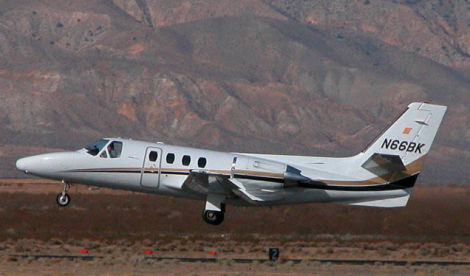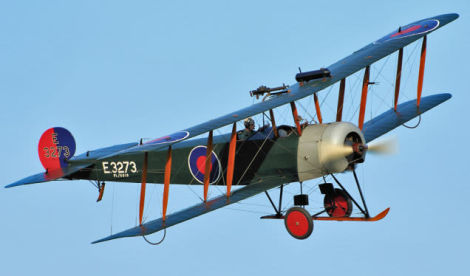Welcome to This Date in Aviation History, getting of you caught up on milestones, important historical events and people in aviation from September 15 through September 18.
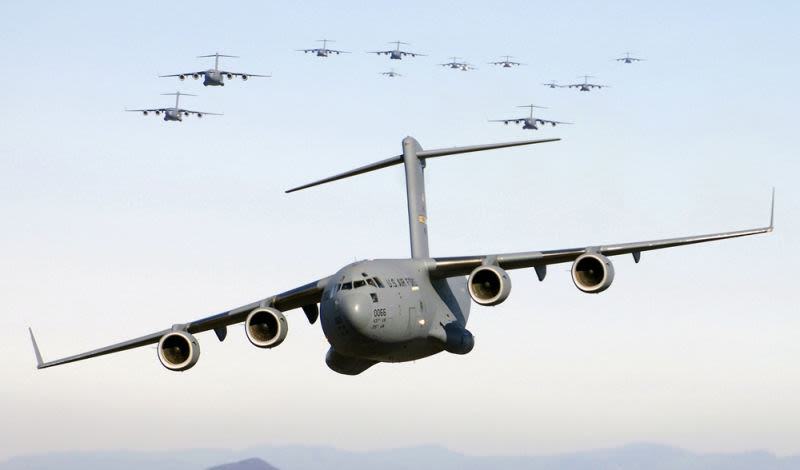
September 15, 1991 – The first flight of the Boeing C-17 Globemaster III. Napoleon Bonaparte (or perhaps Frederick the Great) famously said, “An army marches on its stomach,” meaning that without food and supplies, an army goes nowhere and doesn’t fight. Practically the entire history of warfare has revolved around logistics—getting the army to the fight and getting the supplies to the army—no matter how far from home that fight is. By WWII, the development of large strategic airlifters made that task of supply significantly easier and, by the 1960s, the job was being done by large jet-powered aircraft like the Lockheed C-141 Starlifter and Lockheed C-5 Galaxy.
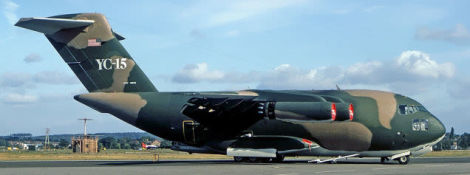
The McDonnell Douglas YC-15, which formed the basis of the C-17.But as the US Air Force looked at the logistics problems of the 1970s, particularly after their experiences in the Vietnam War, they realized that they needed a cargo jet that could not only haul more goods farther but also land on shorter, rougher runways. To deal with these new challenges, the Air force created a set of requirements as part of its Advanced Medium STOL Transport program (AMST) and evaluated two entries: the Boeing YC-14 and the McDonnell Douglas YC-15. Both aircraft took design cues from the Lockheed C-130 Hercules, having a high, straight wing and a raised tail to allow cargo loading in the rear. However, the AMST program was canceled before a winner was chosen, and it wasn’t until 1980, when the Air Force was facing the reality of a fleet of aging C-141s, that they revisited the concept, now designated the C-X program.
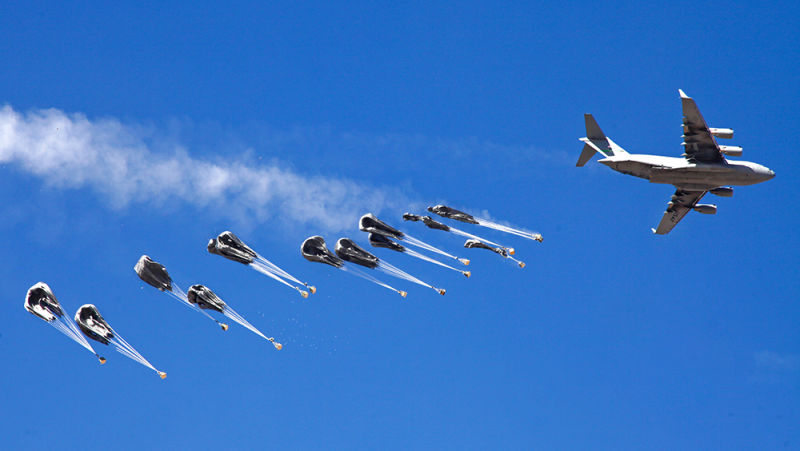
In response to these new requirements, McDonnell Douglas updated their earlier YC-15 design, Boeing brought an updated version of the YC-14, and Lockheed doubled down with one aircraft based on the C-5 as well as an enlarged version of the C-141. Ultimately, the Air Force chose McDonnell Douglas, and gave their aircraft the designation C-17 Globemaster III, a name which pays homage to two earlier airlifters that both carried the nickname, the Douglas C-74 and C-124. Delays in development and a shortage of funds almost led to the cancelation of the project once again, and caused the program to be delayed a further five years. Finally, in 1985, a development contract was awarded, with delivery slated to begin in 1990 (McDonnell Douglas had merged with Boeing in 1997).

The C-17 is powered by four Pratt & Whitney F117 turbofan engines which give it a cruising speed of 515 mph and a range of up to 5,600 miles, depending on the cargo load. It can carry up to 170,900 pounds of cargo, which includes as many as 134 troops or one M1 Abrams main battle tank. The C-17 can also carry three M1126 Stryker infantry vehicles or six M1117 Guardian armored security vehicles. Thrust reversers that direct the jet exhaust upward give the C-17 a stopping distance of as little as 3,500 feet while reducing the dangers of ingesting foreign object debris into the engines. During testing, the C-17 set 33 world records, including a record for STOL capability in which a C-17 took off in less than 1,400 ft, carried a payload of 44,000 pounds to altitude, and then landed in less than 1,400 ft and, in 1998, the C-17 was awarded the Collier Trophy for achievement in aeronautics. The first C-17s entered service in 1993, and at total of 279 were built before production ended in 2015. Globemaster IIIs remain in service with the US Air Force, the Royal Air Force, the Royal Australian Air Force and the Indian Air Force.

September 17, 1959 – The first powered flight of the North American X-15. The decades of the 1950s and 1960s were an extraordinary time in the history of aviation. Following the adoption of the turbojet engine late in WWII, designers raced to develop aircraft that could fly ever higher and faster, even to the edges of space, while seemingly bottomless Cold War defense budgets funded research into aviation. The burgeoning Space Race between the United States and the Soviet Union meant that money for research and development was always in good supply.
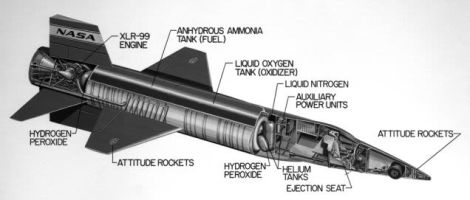
The X-15 was part of a long lineage of experimental aircraft, known collectively as the X planes. Beginning with the Bell X-1, which broke the sound barrier for the first time in 1947, these innovative and often revolutionary aircraft were developed to explore, test and evaluate cutting edge theories about aircraft design and propulsion, and push against the edges of the flight envelope, In 1952, the National Advisory Committee for Aeronautics (NACA, the predecessor to NASA), began investigating the possibilities of space flight and, by 1954, the committee set forth guidelines for an aircraft that could investigate flight at not just supersonic speed, but at hypersonic speeds (above Mach 5), and one that would go to the limits of our atmosphere. NACA selected a team from North American Aviation led by Chief Project Engineer Charles Feltz to design the exotic plane, one that ultimately looked more like a spacecraft than an aircraft. And indeed, the X-15 was intended to fly in both regimes, using traditional flight control surfaces for flight in the atmosphere and reaction controls in the form of hydrogen peroxide thrust rockets for control in the thin air outside the atmosphere. Power for the X-15 came from a single liquid fuel Reaction Motors XLR99 rocket that produced over 70,000 pounds of thrust, though the early flights were carried out using two less powerful rocket motors.
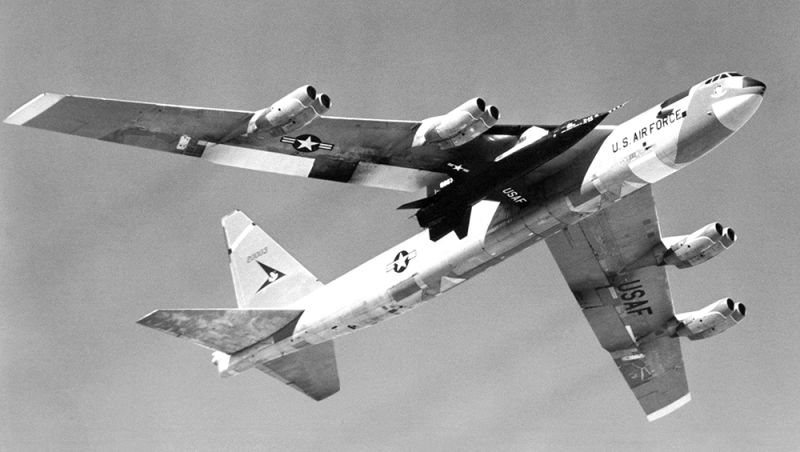
The X-15 made its maiden flight on June 8, 1959 as part of a captive-carry mission with its Boeing NB-52A Stratofortress mother ship. For its first powered flight three months later, North American test pilot Scott Crossfield flew the X-15 to a rather pedestrian speed (for the X-15) of 2,242 mph, about Mach 3, at an altitude of around 16,000 feet. Other test flights went ever faster, eventually reaching a speed of 4,519 mph (7,273 kmh) on October 3, 1967, a record that still stands for a manned aircraft. But it wasn’t all about speed. The X-15 was also about altitude, and reaching the edge of space. In arcing flights that started in Utah, flew over Nevada, and ended at Edwards Air Force Base in California, 13 of the 199 test flights took their pilots to an altitude between 50-60 miles, the entry altitude to space set by the USAF. Flights 90 and 91, piloted by Joseph Walker, reached 66 and 67 miles. Pilots who made these flights were awarded their Astronaut wings (the Fédération Aéronautique Internationale Sporting Code sets the required altitude to be considered an astronaut as 100 km, about 62 miles).
The X-15 test program collected reams of data on hypersonic flight, as well as data that would be used for future aircraft and spacecraft design. A total of three X-15s were built during the program, and two survive. One is on display at the National Air and Space Museum in Washington, DC, and the other resides at the National Museum of the United States Air Force in Dayton, Ohio.

September 17, 1935 – The first flight of the Junkers Ju 87. In the early stages of WWII, the German Blitzkrieg, or “lightning warfare,” was practically unstoppable as the German army stormed across Europe. Concentrations of armored or motorized infantry and tanks struck against Poland, France and the Low Countries hard and fast, but one of the main reasons for the success of the Blitzkrieg strategy was the use of combined arms tactics, with aircraft in close air support of the infantry. The plane that came to symbolize Blitzkrieg more than any other was the Junkers Ju 87 Stuka.
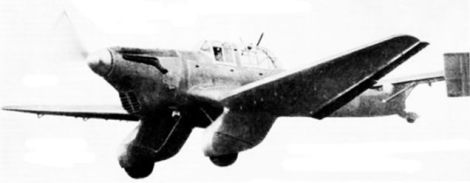
Development of a dedicated ground attack aircraft began as early as 1928. Once Adolf Hitler came to power in 1933, the project became one of great importance, and development was spearheaded by Ernst Udet, a WWI fighter ace and the eventual Director-General of Equipment for the Luftwaffe. Work on the Ju 87 began in 1933 as part of Germany’s Sturzbomber-Programm (the name Stuka is derived from Sturzkampfflugzeug, or “diving warplane”). With some irony, the aircraft was originally powered by a British Rolls-Royce Kestrel V-12 engine, and featured a twin tail to give the rear defensive gunner a clearer field of fire. But the weakly constructed tail broke apart during a test flight, killing the pilots, and designers reverted to a more traditional single vertical stabilizer. The Stuka’s distinctive inverted gull wings were adopted to provide clearance for the landing gear and to improve visibility for the pilot, and automatic pull-up dive brakes allowed the aircraft to recover from a diving attack even if the pilot lost consciousness from high G forces. Fixed, spatted landing gear, which hearkened back to an earlier era of aviation, added strength to the Stuka, and Jericho-Trompete wailing sirens were fitted to the struts as instruments of propaganda meant to strike fear into the Stuka’s targets. For the production aircraft, the original Rolls-Royce engine was swapped for one of German build, a Junkers Jumo 211 inverted V12, the same engine flown in the Junkers Ju 88 and Heinkel He 111.
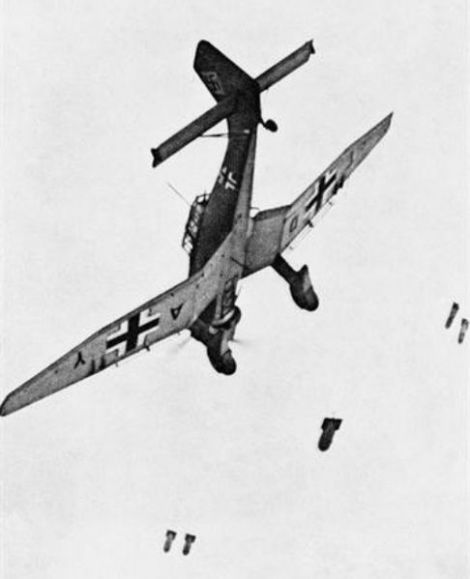
Stukas first saw service in support of the General Francisco Franco’s Nationalists during the Spanish Civil War of 1936, and the dive bomber was instrumental in early German victories of WWII in 1941-1942. Stuka’s worked closely with tanks and infantry to spearhead the invasion of Poland in September 1939, were instrumental in the conquering of northern continental Europe, and were also particularly effective against shipping. But in spite of its prowess as a dive bomber, the Stuka suffered from low speed and poor maneuverability, making it easy prey for faster, more agile Allied fighters. With a maximum speed of just about 240 mph, the Stuka was 100 mph slower than the Hawker Hurricane. As the war progressed, Stuka raids required fighter escort and, when Germany eventually lost air superiority over Europe, the Stuka was rendered much less effective. The bulk of the ground attack missions were taken over by attack variants of the Focke-Wulf Fw 190, but the Ju 87 soldiered on and served until the end of the war. The Stuka was retired at the end of the war and, of the more than 6,500 that were produced, only two remain. One is on display at the Museum of Science and Industry in Chicago, and the other resides at the Royal Air Force Museum in London.
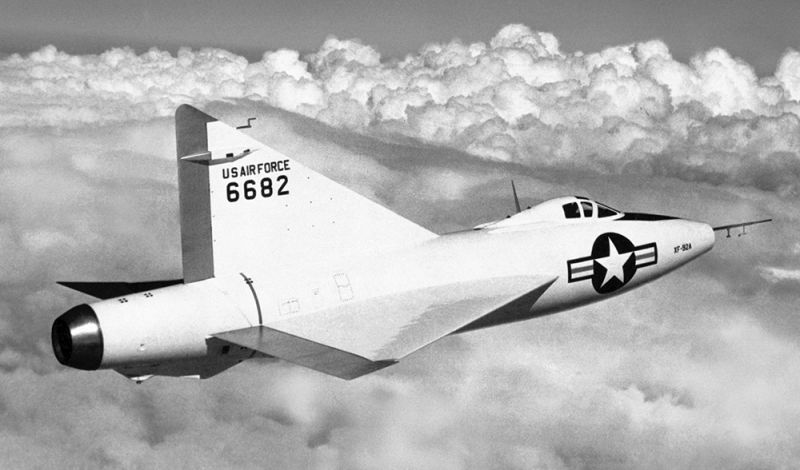
September 18, 1948 – The first flight of the Convair XF-92. As the Allies moved across Germany in the closing stages of WWII, they discovered a trove of secret and advanced aircraft that the Germans had been working on. Not only did the Germans field the first jet-powered and the first rocket-powered fighters, they had been experimenting with innovative designs such as aircraft with swept wings, and one German engineer in particular, Alexander Lippisch, had made important discoveries in the use of delta wings and tailless aircraft. Lippisch’s work had shown that a delta wing would be effective for high speed flight, and he had begun work on the concept with the DM-1, a delta-winged glider with delta tail. As a spoil of war, the Americans brought the DM-1, along with Dr. Lippisch, back to the United States as part of Operation Paperclip.
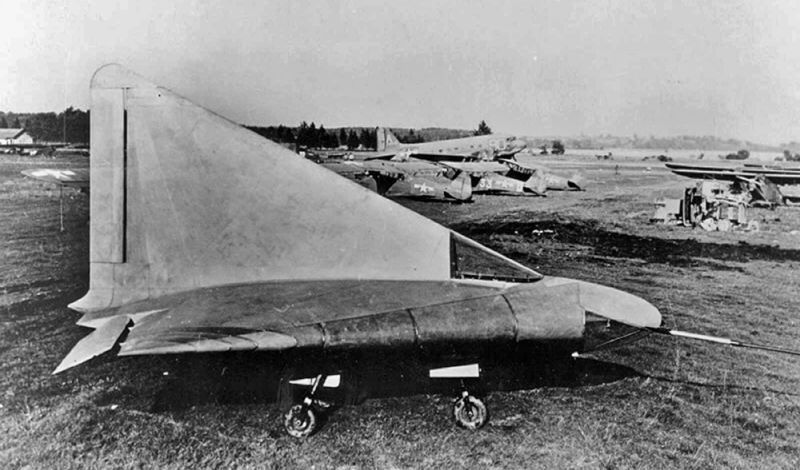
In the summer of 1945, Consolidated-Vultee, later known as Convair, had begun work on a supersonic interceptor for the soon-to-be US Air Force that would be powered by mixture of rocket and turbojet power and feature a swept wing and V-tail. However, testing showed that this arrangement was unsuitable. Meanwhile, the DM-1 had arrived at the Langley Research Center in Virginia and had been tested by National Advisory Committee for Aeronautics (NACA) engineers. Data from these tests was then forwarded to Convair, and after a meeting with Dr. Lippisch himself, the company decided to redesign their interceptor with a delta planform, one that looked remarkably like the DM-1 glider.
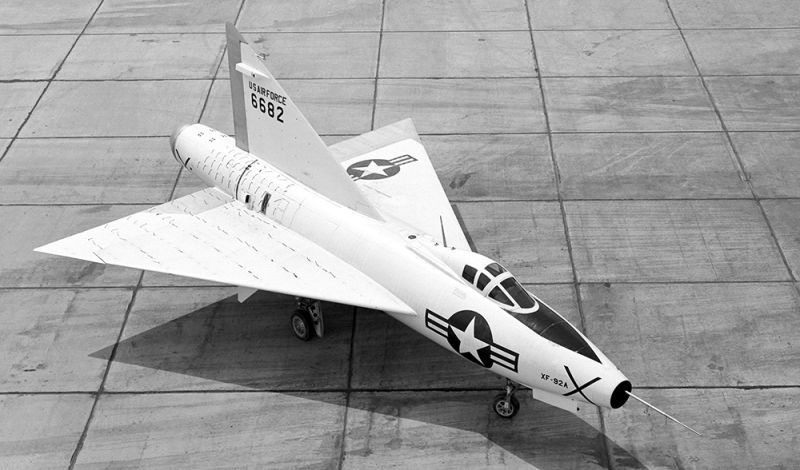
Hampered by the poor thrust of the early turbojet engines, Convair decided to combine a Westinghouse J30 jet with six nitro-methane rockets to boost the fighter’s top speed. However, arrangement allowed for just 10 minutes of cruising time and five minutes of combat, only a minor improvement over the Messerschmitt Me 163 Komet rocket plane of WWII. Convair built a flying mockup, dubbed the Model 7002, from scavenged parts of other aircraft and fitted it with a more powerful Allison J33 engine. On June 9 1948, the world’s first tailless delta aircraft took flight and, when it showed good flying characteristics, the Army promptly bought the prototype and dubbed it the XF-92A. The rocket-powered XF-92 was canceled.
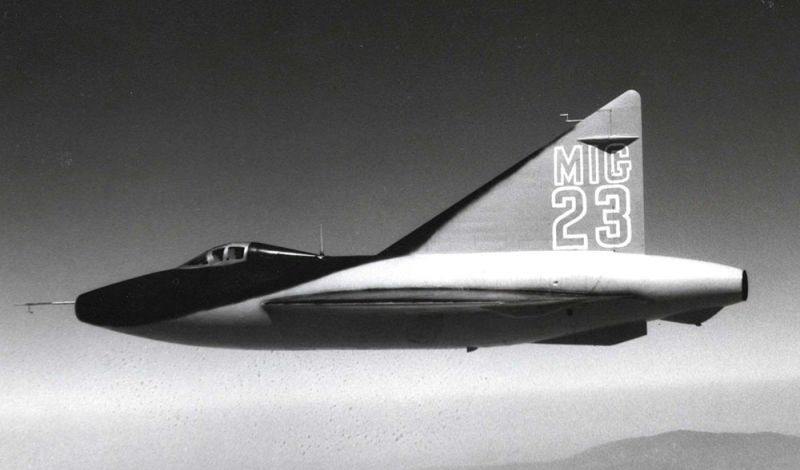
Testing of the XF-92A commenced, and noted test pilots such as Scott Crossfield and Chuck Yeager each took turns in the cockpit. Though mostly stable, the pilots complained of a lack of power and maneuverability, though Yeager was able to nudge the aircraft just past the speed of sound. The delta design also offered very low landing speeds, though with a high angle of attack. Despite the XF-92's less-than-stellar flying characteristics, it had an outsized influence on the future of Convair and the delta wing in general. With knowledge gained from testing, the company went on to develop thee F-102 Delta Dagger, F-106 Delta Dart, B-58 Hustler, all of which went on to successful careers with the Air Force. The sole XF-92A is now on display at the US Air Force Museum in Dayton, Ohio.
Short Takeoff
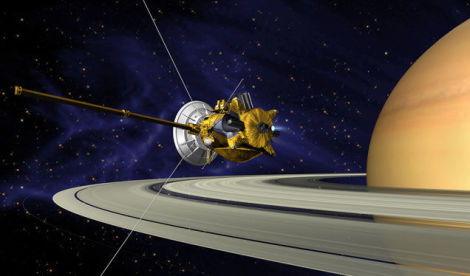
September 15, 2017 – The Cassini orbiter is intentionally crashed on Saturn. Launched on October 15, 1997 as a combined effort between NASA, the European Space Agency, and the Italian Space Agency. Cassini-Huygens was a two-part robotic spacecraft consisting of the Cassini orbiter and the Huygens lander. The paired spacecraft passed by Venus and Jupiter before beginning its orbit of Saturn on July 1, 2004, and the Huygens lander descended to the moon Titan on January 14, 2005 marking the first landing on a body in the outer Solar System and the first landing on a moon other than Earth’s moon. Huygens transmitted photos and other data via Cassini back to Earth, while Cassini continued to orbit Saturn. The so-called Grand Finale of the mission saw Cassini fly between the planet and its rings 25 times and return photographs of Saturn’s atmosphere. In order to avoid potential contamination of Saturn’s moons, which might have conditions suitable for life, Cassini was intentionally deorbited to the planet’s atmosphere where it will burn up and destroy the spacecraft’s plutonium fuel.

September 15, 1978 – The death of Willy Messerschmitt. Born in 1898, Messerschmitt began his design career building sail planes during WWI, then moved on to build small sport planes and small passenger planes. In 1936, he won the competition to provide the Luftwaffe with a new frontline fighter, the Bf 109, one of the war’s iconic fighters and an aircraft which was produced in greater numbers than any other aircraft in history. With restrictions placed on the production of military equipment after the war, Messerschmitt turned to the manufacture of sewing machines, prefabricated buildings, and the Messerschmitt Kabinenroller automobile. He also exported his aircraft design talents to other countries, designing the Hispano HA-200 jet trainer for Spain in 1952 before he was allowed to return to aircraft manufacturing, producing the Fiat G91 and the Lockheed F-104 Starfighter under license for the West German Luftwaffe. His final design was the Helwan HA-300, supersonic interceptor for the Egyptian air force.
September 15, 1969 – The first flight of the Cessna Citation I, a business jet developed by the Wichita-based Cessna Aircraft Company and the first in a line of business jets. Development began in 1968 when Cessna chose to market a smaller bizjet that would compete with current turboprop aircraft instead of the established bizjet market. Unlike the competing Learjet 25, which was powered by turbojets, the Citation I was powered by Pratt & Whitney Canada JT15D turbofans and, though it was slower, the addition of thrust reversers made it compatible with shorter airfields. The Citation I was produced from 1969-1985, and a total of 689 were built.
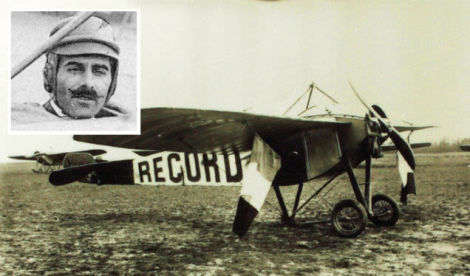
September 15, 1911 – The death of Édouard Nieuport, a French aviation pioneer and founder, along with his brother Charles, of the Société Anonyme Des Éstablissements Nieuport, better known simply as Nieuport. Édouard was known for his monoplane designs in an era when most manufacturers were producing biplanes, and he set speed records flying his own aircraft powered by engines of his own design. Édouard was killed in a flying accident in 1911, followed two years later by the death of his brother Charles, also in a flying accidents. However, their company went on to become one of the major manufacturers of fighter aircraft in WWI.
September 16, 2013 – The first flight of the Bombardier CSeries (CS100),a narrow-body twin-engine medium-range regional airliner manufactured by Bombardier Aerospace of Canada. Following their unsuccessful takeover of Fokker in 1996, Bombardier considered a new regional jet, but instead chose to enlarge their existing successful line of CRJ regional jets. With the launch of the Embraer E-Jet line in 2002, Bombardier revisited the idea and developed their first regional jet with 5-across seating and engines in pods under the wing rather than at the rear of the aircraft. After a lengthy test program, the first CS100 was delivered to Swiss Global Air Lines in June 2016, with Bombardier having firm orders for 123 more CS100 airliners along with 235 of the larger CS300. In 2017, Bombardier formed a partnership with Airbus, with the European manufacturer taking a 50.01% share of the company, and the CS100 was subsequently renamed the Airbus A220.
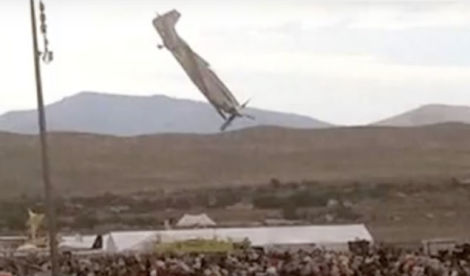
September 16, 2011– A modified North American P-51D Mustang crashes into the grandstands at the Reno Air Races. Seventy-four-year-old pilot Jimmy Leeward was piloting his highly modified North American P-51D Mustang (NX79111) around pylon number 8 at the Reno Air Races in Nevada when the aircraft suddenly pitched up violently and plunged into the grandstands, killing Leeward along with 10 spectators. During the race, Leeward reached a top speed of 530 mph, and investigators later determined that the trim tab on the left elevator began to flutter and then broke off, leading to the loss of control. The sudden departure from controlled flight exerted 17Gs on the pilot, which would have rendered him unable to move and likely caused him to lose consciousness. The breakage was traced to the reuse of locknuts that were only intended to be used once. The crash was the fourth-deadliest accident in US air show history.
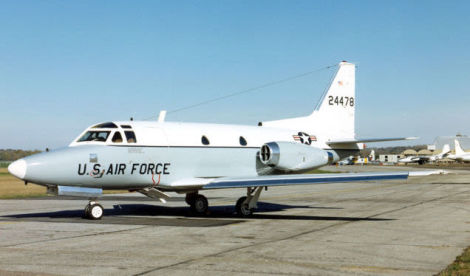
September 16, 1959 – The first flight of the North American Sabreliner, a mid-sized business jet developed by North American Aviation for both the military and civilian market. Development began as part of the US Air Force’s Utility Trainer Experimental (UTX) program to find an aircraft that could function both as a utility transport and a combat readiness trainer, and the name Sabreliner was chosen due to the resemblance of the tail and wings to the North American F-86 Sabre fighter. The US military adopted the Sabreliner as the T-39, while the civilian version was originally marketed as the Series 40, though subsequent variants saw the 60, 70, 75 and 80. The Navy also adopted the T-39 for radar operator training. More than 800 Sabreliners were produced from 1959-1982.
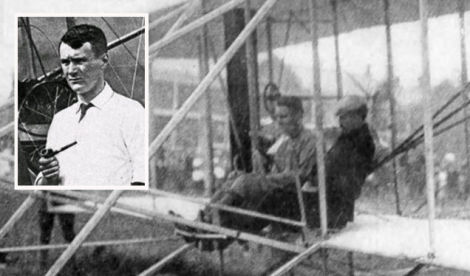
September 17, 1908 – The death of Thomas Selfridge. Selfridge was born on February 8, 1882 and served in the Aeronautical Division of the US Army Signal Corps after his graduation from the United States Military Academy in 1903. As part of an effort to gain interest from the US Army in airplanes, Orville Wright traveled to Fort Myer near Washington, DC to demonstrate the Wright Flyer to officials from the Army. On one flight, Orville piloted the Flyer around the base and Selfridge rode as a passenger while the plane reached an altitude of 150 feet. On the fifth circuit, the right propeller broke, and pieces of the propeller damaged the struts and wiring of the Flyer. Orville managed to glide the Flyer to the ground, but landed nose first. Orville was severely injured, but Selfridge died of a fracture to the base of his skull, making him the first person in history to die in a plane crash.

September 18, 1984 – Joe Kittinger completes the first solo transatlantic balloon flight. Kittinger, a retired colonel in the US Air Force, is perhaps best known for taking part in Project Manhigh and Project Excelsior where he set a world record in 1960 for a parachute jump from a balloon floating at 102,800 feet. After his retirement from the Air Force, Kittinger retained his interest in ballooning and made the first solo crossing of the Atlantic Ocean in a balloon named Rosie O’Grady’s Balloon Of Peace. Kittinger departed from Maine on September 14 and landed in Montenotte, Italy and, according to the Fédération Aéronautique Internationale (FAI), the governing body for air sports, the flight set the record for the longest gas balloon distance for its class at 3,544 miles.
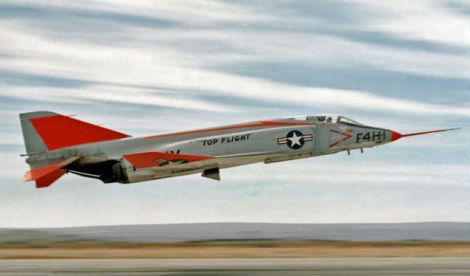
September 18, 1962 – The US Air Force and US Navy adopt the Tri-Service Aircraft Designation System. Prior to 1962, aircraft of the US Air Force and US Navy and US Marine Corps followed different systems for designating their aircraft, even if the same plane flew for different branches. For example, the North American Mitchell bomber was known as the B-25 (B for bomber) in the US Army Air Forces, while the same aircraft in Marine Corps service was known as the PBJ (PB for Patrol Bomber, J being the designation for North American Aviation). With the new system, aircraft of the Department of the Navy were redesignated, and all aircraft would follow the Air Force system, with a prefix denoting the aircraft’s main mission: F for fighter, A for attack, B for bomber, X for experimental, and so on.
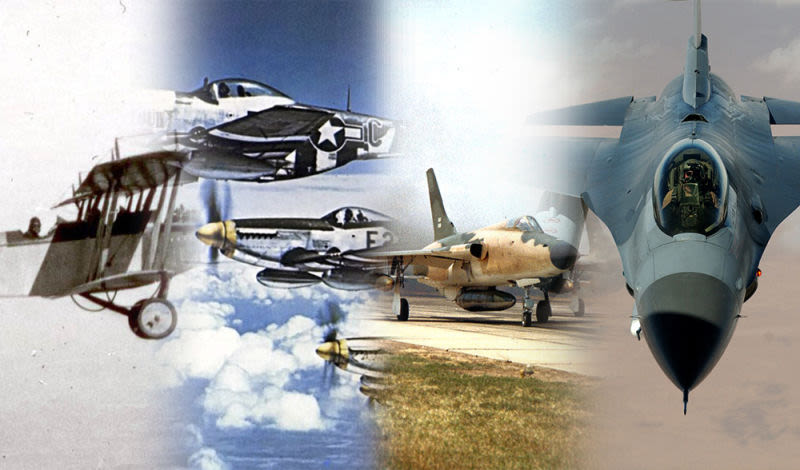
September 18, 1947 – The US Air Force becomes an independent branch of the US military. On July 16, 1947, President Harry S Truman signed the National Security Act of 1947, which mandated a sweeping reorganization of US military structure. The US Army Air Forces had grown to enormous size during WWII, and it was separated from the Department of the Army to become the Department of the Air Force. The Act also called for the formation of the National Security Council, the Central Intelligence Agency, and the Joint Chiefs of Staff. The Air Force officially became active on September 18, 1947 when Stuart Symington was sworn in as the first Secretary of the Air Force. General Carl A. Spaatz, former commander of Strategic Air Forces in Europe, was named its first Chief of Staff. Throughout the Cold War, the Korean War, the Vietnam War, and through all the conflicts since, the US Air Force has remained at the forefront of technological advancement and readiness, and is arguably the most powerful and capable arm of military aviation in the world today.
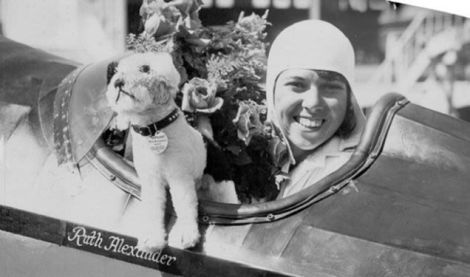
September 18, 1930 – The death of Ruth Alexander. Alexander was a pioneering American aviatrix who began her brief flying career in 1929 and, within days of becoming the 65th licensed woman pilot in the US, she set an altitude record for women of 15,718 feet. She was also the second woman in the US to become a licensed glider pilot, and the first woman glider instructor. In July 1930 Alexander set a new world altitude record for both men and women of 26,000 feet, but died just two months later when she crashed into a hillside while piloting her Barling NB-3 during an attempt at a transcontinental flight.
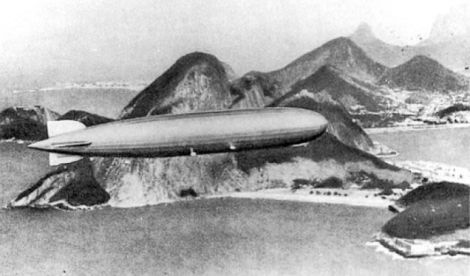
September 18, 1928 – The first flight of the Graf Zeppelin (LZ 127), a German rigid airship and the first airship to provide transatlantic passenger service. The airship was named after Count (Graf) Ferdinand von Zeppelin, a former general in the German army and the founder of the Luftschiffbau Zeppelin. His name has since become synonymous with rigid airships. In its lifetime, LZ 127 made 590 flights covering a total of over one million miles, including a circumnavigation of the globe in 1929. Despite its years of service, the Graf Zeppelin was scrapped in 1940 so its duralumin frame could be used for the production of warplanes.
September 18, 1913 – The first flight of the Avro 504, a biplane fighter of WWI that served both the Royal Flying Corps and the Royal Naval Air Service. The 504 was developed from the earlier Avro 500 and was powered by a Gnome Lambda 7-cylinder rotary engine to a top speed of 90 mph. Over 10,000 were produced from 1913-1930, and it holds the distinction of being the most-produced aircraft of any kind in WWI. Of all wood construction, the 504 was quickly rendered obsolete by more modern fighters after the war, when it became the standard RAF trainer. Many surplus aircraft entered the civilian market. A number have survived 100 years after their production, and at least two remain airworthy.
Connecting Flights
If you enjoy these Aviation History posts, please let me know in the comments. And if you missed any of the past articles, you can find them all at Planelopnik History. You can also find more stories about aviation, aviators and airplane oddities at Wingspan.
